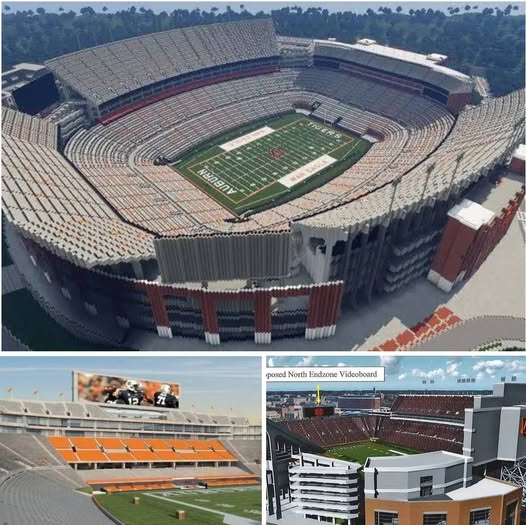In a move that has sent shockwaves through the landscape of college football and sports architecture, the Auburn Tigers have officially announced a record-shattering $3.1 billion renovation of Jordan-Hare Stadium—a project that will not only redefine the experience of SEC football but will also stand as a monumental symbol of Auburn University’s ambitions in the new era of collegiate athletics. The comprehensive overhaul, already being referred to as the most ambitious stadium transformation in NCAA history, will incorporate state-of-the-art technology, lavish luxury suites, a dramatic increase in seating capacity to 120,000, and a host of never-before-seen innovations designed to elevate the stadium into a futuristic coliseum.
Jordan-Hare Stadium, one of college football’s most iconic venues, has long been a fortress for the Tigers, a place where tradition meets intensity and where generations of fans have gathered to roar for the orange and blue. But this transformation signals more than just an expansion—it is an audacious declaration that Auburn is ready to compete not only on the field but also in the business of college athletics, entertainment, and fan engagement. In an era where conference realignments, NIL dynamics, and media rights deals have fundamentally reshaped college sports, Auburn’s leadership has chosen to respond not with hesitation but with vision and boldness.
At the heart of the renovation is a dramatic increase in stadium capacity—from the current 88,000 to a staggering 120,000 seats—instantly catapulting Jordan-Hare into the elite tier of global sports venues. This expansion will make it the largest stadium in the Southeastern Conference and the second-largest in the entire country, trailing only Michigan Stadium in Ann Arbor. For Auburn fans, the message is clear: there will be room for every member of the Tiger family, from the legacy season ticket holders to the next generation of passionate students, alumni, and supporters.
But the numbers alone don’t tell the full story. The renovation is being hailed as a revolution in fan experience, seamlessly integrating technology and luxury in ways that are more akin to high-end professional arenas than traditional college stadiums. Auburn University, in partnership with several global architectural and tech firms, is set to introduce smart seat technology that includes wireless charging ports, customizable climate controls, and immersive augmented reality options. Fans will be able to order food, access instant replays, engage in interactive game stats, and even participate in live polls and contests—all from their seats via an integrated app tied directly to the stadium’s infrastructure.
The stadium will also debut over 200 new luxury suites, each outfitted with high-end finishes, panoramic views, concierge service, private dining, and exclusive access to VIP lounges. These suites are being marketed not just to wealthy donors and corporate sponsors, but also to alumni groups and football families who want to experience the game in opulent comfort. Additionally, Auburn plans to unveil multiple “sky plazas”—multi-tiered social spaces that combine bar-style seating, large video boards, live entertainment, and gourmet food options, creating an atmosphere that’s part stadium, part upscale sports bar, and part concert venue.
One of the centerpieces of the renovation is a new, retractable roof that can be deployed over the central seating area in case of inclement weather—another first for any SEC stadium. While the stadium will remain primarily open-air to preserve the traditional game-day atmosphere, the retractable feature will allow for greater flexibility, comfort, and event planning. It’s a bold move designed to accommodate not just football, but a wide variety of events ranging from concerts and esports tournaments to high school championships and community festivals.
The playing field itself is set to undergo a transformation as well. Auburn will transition to a hybrid grass-turf surface that offers the resilience of artificial turf with the natural feel of grass. This innovation is intended to reduce injuries, improve drainage, and allow for faster turnaround between events. The new field will also include embedded sensors that track player movement and monitor surface conditions in real-time—data that can be shared with coaching staff to enhance performance and safety.
But perhaps the most radical element of Auburn’s vision is its integration of fan engagement with emerging technology. In what may be a first for any stadium in the United States, Auburn plans to implement AI-powered “fan assistants”—interactive kiosks and mobile guides that will help attendees navigate the stadium, locate parking, find friends, access merchandise, and even translate menus or announcements in multiple languages. The goal is to create a fully personalized and inclusive experience for fans of all backgrounds, ages, and abilities.
From the outside, the new Jordan-Hare will undergo a complete architectural facelift, with sleek lines, illuminated glass towers, and digital exterior panels that can be programmed to showcase team colors, scores, highlight reels, or tributes to Auburn legends. The new façade will reflect both tradition and innovation, honoring Auburn’s rich past while embracing the future. A massive Tiger Walk statue and heritage plaza will welcome fans at the main entrance, surrounded by interactive history walls and digital monuments to former players, coaches, and championship teams.
Financially, the $3.1 billion project will be funded through a combination of private donations, naming rights deals, corporate sponsorships, and university-backed financing. Already, several major alumni donors have pledged nine-figure contributions to the effort, with early projections indicating that suite sales and premium ticketing could recoup a significant portion of costs within the first decade of operation. Auburn’s administration has been transparent about its strategy, emphasizing that the investment is not just in a building, but in the long-term brand, revenue stream, and competitive sustainability of the university.



